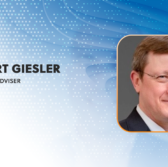The global race to build and deploy hypersonic weapons and technologies is heating up, but the United States is falling behind some of its key competitors in this critical area. China and Russia have demonstrated hypersonic capabilities, while the U.S. remains in the testing phase.
Experts from government, industry and academia gathered at the ExecutiveBiz 2023 Hypersonics Forum to discuss why our hypersonics programs aren’t seeing more success, what must be done to get them on the right track and what they hope lies ahead for American hypersonics as the technology becomes more and more crucial to national security.

Curious about the technologies paving the way for innovation in the skies and in space? Join the ExecutiveBiz Space Technologies Forum on Aug. 29 to hear from top government and industry leaders on the technologies shaping the space domain. Dr. Frank Turner, technical director of the Space Development Agency, will keynote. Register here.
Dr. Mark Lewis, President and CEO of the Purdue Applied Research Institute, asserted that one of the main roadblocks to hypersonic success lies within the testing process. He urged that we need to “move out of this paradigm that we’re in now, where we test every couple of months, sometimes every couple of years, and get to a flight testing rhythm where we can be testing almost on a weekly basis.”
The former acting deputy under secretary of defense for research and engineering argued that more frequent testing is exactly what’s needed to “advance the state of the art to where it needs to be.”

Adam Jones, senior scientific and technical manager for hypersonic weapon systems development and integration for the Naval Surface Warfare Center Dahlgren Division, shared that more frequent testing could make tough hypersonics problems easier to break up and solve.
“I think a lot of times what we do in the test programs is we jam a lot of requirements into one test,” Jones explained. “If there are smart ways to decompose these tough problems into smaller chunks where we can go out, test smartly, collect that piece of data and bring it back, that’s, to me, a smart way of pushing the ball down the road and innovating.”
More testing will also help hypersonics experts to learn more quickly from failures, which Rachel Hickman identified as critical to hypersonics development. But in order to learn from these failures, the testing infrastructure needs to be set up in a way that supports data collection, weapon recovery and reusability.
“Failures are where we learn most,” said Hickman, division chief for mission execution and test resources at the Army Space and Missile Defense Command Technical Center. “What I see is that we’re typically putting architecture together for a nominal flight. And that’s what we really have the resources for, but we’re really not putting in redundancies to get data on failures because we don’t know what that would be.”
“When we capture that data, that’s where the data exchange is so important — to make sure that each of the ranges are harmonizing on what we’re learning and how we’re reacting to those failures. That’s where we learn where we need to diversify certain parts of the architecture, where we need to have overlaps, where we need to scale and add more investments,” Hickman added.
Dr. Lewis concurred with his fellow panelist and noted, “When we break things, we can fix them and move forward with our programs. That’s what we need to do.”
He also highlighted the importance of recoverability in hypersonic testing as a key component of learning from failures. “The bottom line is there is tremendous value in recovering it, looking at it, even if you don’t reuse it. I love the idea of reusability because it gets cost down, but even if you don’t reuse it, just being able to see it and examine it is a key capability,” Dr. Lewis said.
Dan Ensminger, director of test, evaluation and modeling for the U.S. Naval Air Systems Command, shared his perspective on two of the most urgent testing infrastructure changes needed for programs like the Navy’s Hypersonic Air Launched Offensive Anti-Surface, or HALO, weapon.

“One is we need to be a little bit smaller to fit the magazines on the carrier and be carried on a fighter size aircraft as opposed to B-52 type thing. And we also have to fit the magazine on the ship,” he said.
“Then the other thing is, a lot of test infrastructure for hypersonics has been designed to either go for fixed land targets where you can easily instrument the area where it’s fitting or for targets up in the air… One of our challenges we’re seeing is instrumenting the target area for a ship that’s out at sea and trying to pick up and track the thing in — where it’s really interesting for us is where actually going to hit the target that’s moving,” Ensminger shared.
Geoffrey Wilson, who serves as the test and evaluation/science and technology program manager for the Department of Defense’s Test Resource Management Center, agreed with his fellow panelists that the cadence of hypersonic testing must increase, and he shared his perspective from his role in laying out the strategy for the DOD’s hypersonic test infrastructure modernization efforts.
“We’ve got big goals that we want to get the department to execute one flight test a week or 52 flight tests a year,” Wilson shared. “And there are a lot of bottlenecks when it comes to test infrastructure to achieve those goals. So we’ve built a pretty robust team to lay out the critical bottlenecks in aerodynamics, aero propulsion, aerothermal testing, scoring lethality and flight test, and then we are — as fast as we can — leveraging the dollars that we get allocated to the department.”
“We’ve got strong support on the hill to make test infrastructure not just an enabler, but also an accelerator for hypersonic system development,” he noted.
But the hypersonic testing modernization effort reaches beyond just the DOD and the federal government, Wilson added, and the country needs support from all areas of the innovation ecosystem.
“The test infrastructure modernization is really a whole-of-nation effort,” Wilson said. “Traditionally, when the department modernizes its test infrastructure, it focuses on DOD test infrastructure. But because of the uniqueness of the conditions that are required for hypersonics in terms of high temperature, high pressure, exotic materials, we actually rely heavily not just on DOD test infrastructure, not just on even NASA test infrastructure, but also on industry and in some cases academia.”
When asked by panel moderator Kevin Kelly, chairman and CEO of Arcfield, what one change Wilson would make to the testing and evaluation environment of hypersonic weapons in the United States, Wilson urged more risk taking.
“We still use a lot of the same analog telemetry capabilities that were developed in the sixties. So I would say particularly as the program manager for an S&T program, [we need] the willingness for our T&E community as a whole to accept more risk when it comes to deploying instrumentation and then going after new ideas and concepts like space-based architectures, autonomous flight safety — those are things that industry has already adopted when it comes to putting things into harsh environments,” Wilson said.
“If I can’t get unlimited budgets, which I can’t, then I would like the T&E community as a whole to take more risk,” he added.





